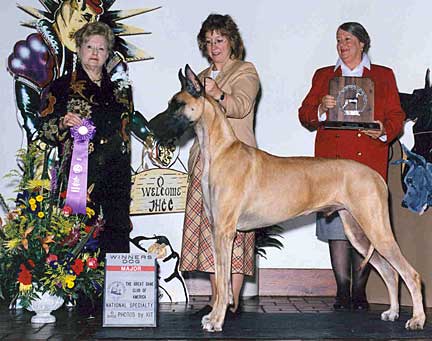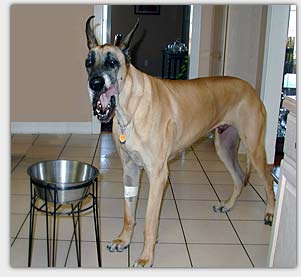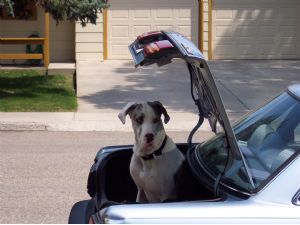The other day, I stopped in at the pet store to look at the puppies. Just to look, you understand. They had several very delightful puppies, but one in particular caught my attention. It was a Great Dane, still a puppy and gangly in the legs, but her paws were quite large and indicated that she would grow to be a Big Dog.
Normally I don't go for the Big Dogs, but she seemed unusual. She had white fur with blue-black spots all over. One eye was dark colored, but the other eye was dark colored on top, and a lighter blue on the bottom, as if her eyes were spotted like her fur. She looked at me through the glass of her cage and I had the distinct impression that we understood something together.

The spotted Great Dane (blue merle) in the picture is similar to the one I saw in the pet store. She is 8 weeks old, and so is the boxer sitting in front of her. (Photo from Hunypunkin's blog)
Alas, I had to leave her in the store (no pets allowed in my apartment, my apartment is WAY too small for as big as she would become, etc.). But I have not forgotten her and so I am curious to find out more about her breed. I was especially curious to know how much exercise Great Danes need. When I've seen people walking them, they seem to walk sort of gingerly, as if their legs are fragile because of their size. Yet also because of their size, wouldn't they want to be pretty active?

This is the Great Dane Lady's prize-winning Great Dane. Note that the tip of this dog's ears come up to the shoulders of the woman holding his leash.

This is Gambler, eating from a dish placed appropriate to his height. You can see how he likes it. (Photo from DaDane of DaWeek)

This Great Dane is ready to go! (Photo from a posting at Terrific Pets)
Dog Breed Information Center, Great Dane
Great Dane Adoption Society (UK), Caring for Great Danes and information about bloat
Harlequin Haven Great Dane Rescue FAQ's
Yahoo Pets, Great Dane
For a great place to adopt a Great Dane in the Midwest, check out Great Dane Rescue in Ohio
Normally I don't go for the Big Dogs, but she seemed unusual. She had white fur with blue-black spots all over. One eye was dark colored, but the other eye was dark colored on top, and a lighter blue on the bottom, as if her eyes were spotted like her fur. She looked at me through the glass of her cage and I had the distinct impression that we understood something together.

The spotted Great Dane (blue merle) in the picture is similar to the one I saw in the pet store. She is 8 weeks old, and so is the boxer sitting in front of her. (Photo from Hunypunkin's blog)
Alas, I had to leave her in the store (no pets allowed in my apartment, my apartment is WAY too small for as big as she would become, etc.). But I have not forgotten her and so I am curious to find out more about her breed. I was especially curious to know how much exercise Great Danes need. When I've seen people walking them, they seem to walk sort of gingerly, as if their legs are fragile because of their size. Yet also because of their size, wouldn't they want to be pretty active?
- The first thing to note about Great Danes is their size: 28 to 34 inches high. That's almost a yard tall. That's roughly half my height.

This is the Great Dane Lady's prize-winning Great Dane. Note that the tip of this dog's ears come up to the shoulders of the woman holding his leash.
- Great Danes can weigh anywhere from 100 to 200 pounds, depending on their sex and other characteristics.
- I know you're thinking, Can I ride that Great Dane like a pony? In fact, although this is an enormous dog, even if you put only a small child on its back, you can cause serious damage, possibly even to the point of paralyzing the dog.
- This breed dates back to the way olden times (like, before 1000 A.D.) and is the result of crossing Mastiffs with Irish Wolfhounds to make a dog that could hunt wild boars. Apparently, Mastiff + Wolfhound = huge and strong, yet sleek and agile.
- Exercise is definitely an issue for Great Danes. While still a puppy, it is important not to allow the dog to gallop for several hours at a time because it can injure its growing bones.
- As adults, Great Danes do need plenty of exercise, at least one long walk per day. But perhaps because of potential joint issues, especially in the hips where this breed is prone to injury, it might be a good idea to assume a more stately pace, and lengthen the distance you walk together.
- Great Danes also need a soft bed to lie down on, again, to avoid damaging their joints.
- Another issue related to their size: Great Danes' food bowls should be placed chest high. They won't need to bend down to reach the food, which will help prevent digestive problems and will also avoid potential damage to shoulder joints.

This is Gambler, eating from a dish placed appropriate to his height. You can see how he likes it. (Photo from DaDane of DaWeek)
- The specific digestive problem that Great Danes are prone to is bloating, meaning the stomach swells with gas or air. This may sound like no big deal, but it can progress very rapidly within minutes, and the stomach gets all twisted, so that often it is fatal. Large dogs with deep chests are often at risk for this sort of thing. Lots of things can lead to bloating, such as improper food, eating too quickly, or high stress. One Great Dane adoption agency recommends keeping a bottle of antacid on hand at all times, and the number to call the vet handy.
- Great Danes like to be around people, and one of the ways they express their fondness for you is to lean against you. This might be nice, but since they're so big, you might not enjoy it that much, especially if the person the dog is leaning against is a small child. Some people recommend training Great Danes not to do this.
- They also like sitting on your lap and offering you their paw to shake or touch. They definitely like to be given attention.
- Generally, Great Danes don't bark much, but they will bark to let you know if there's a real problem. However, because Great Danes like people so much, and because they're good at towing things around, if a thief is friendly enough to the dog, it may even go so far as to help the thief carry things out of your house.

This Great Dane is ready to go! (Photo from a posting at Terrific Pets)
- Because it's very difficult to bathe a dog of this size, many vets recommend frequent brushing and grooming, which will help reduce the number of baths the dog will need.
- Oh, and the name has nothing to do with Denmark. "Great Dane" is an English translation of the French grand Danois. Why the French called the dogs Danish, and why the English persisted in doing that is unknown.
Dog Breed Information Center, Great Dane
Great Dane Adoption Society (UK), Caring for Great Danes and information about bloat
Harlequin Haven Great Dane Rescue FAQ's
Yahoo Pets, Great Dane
For a great place to adopt a Great Dane in the Midwest, check out Great Dane Rescue in Ohio
No comments:
Post a Comment
If you're a spammer, there's no point posting a comment. It will automatically get filtered out or deleted. Comments from real people, however, are always very welcome!